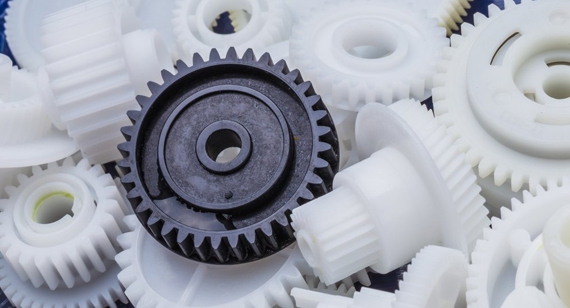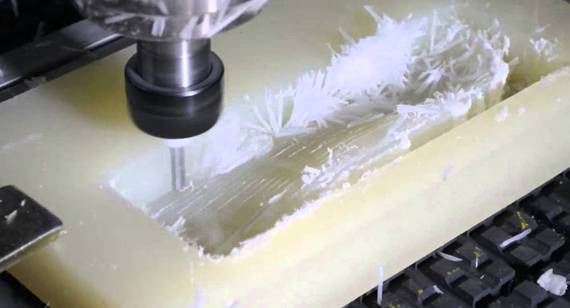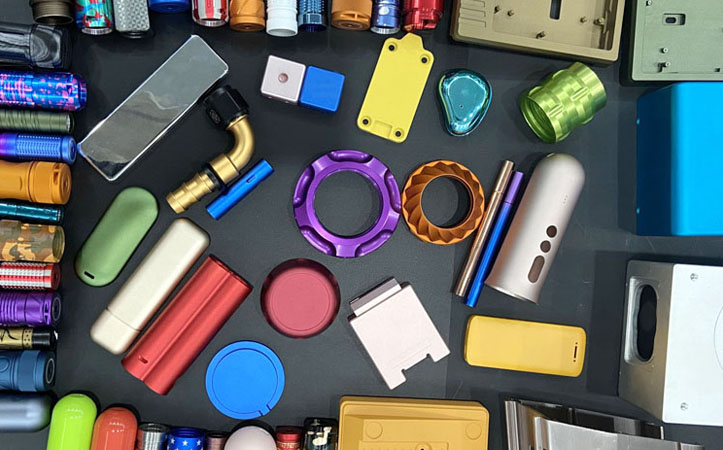15 years one-stop China custom CNC machining parts factory
 329 |
Published by VMT at Oct 16 2024
329 |
Published by VMT at Oct 16 2024
Delrin, also known as polyoxymethylene (POM), is a popular thermoplastic used in a variety of industries due to its excellent machinability, strength, and durability. For CNC machining services, Delrin offers many advantages over other plastics and metals, making it a go-to material for both prototyping and high-volume production. However, working with Delrin requires specific techniques to ensure precision and optimal results. This guide will cover everything you need to know about Delrin machining, from its properties and applications to machining tips and finishing processes.
Delrin, a trademarked version of polyoxymethylene (POM) produced by DuPont, is an engineering plastic known for its high stiffness, low friction, and superior dimensional stability. It is a crystalline polymer that offers exceptional mechanical properties and is frequently used for parts that require strength, durability, and precision. In the world of custom CNC machining, Delrin is highly valued for its machinability, making it ideal for producing a wide range of complex parts with tight tolerances.

Delrin’s unique combination of properties makes it an ideal material for machining. Unlike other thermoplastics, Delrin remains dimensionally stable even when subjected to high levels of mechanical stress. Its machinability, combined with its high strength and toughness, makes it a preferred choice in industries such as automotive, electronics, and medical devices.
Delrin offers numerous benefits for CNC machining operations, making it a highly versatile material for producing precision parts. Below are the key advantages of machining Delrin:
Machinability
Delrin is one of the most machinable plastics available. It cuts smoothly and does not gum up tools, making it easy to create precise parts with high accuracy. Delrin’s ability to be machined at high speeds with minimal tool wear makes it an excellent option for CNC machining factory looking to maximize production efficiency.
Excellent Dimensional Stability
Delrin maintains its shape and size under stress, temperature variations, and moisture exposure. This is a critical feature for parts that require high dimensional accuracy over time, such as CNC prototype machining components used in aerospace, automotive, or medical applications.
Strength, Toughness, and Impact Resistance
Despite its lightweight nature, Delrin offers excellent strength and toughness. It can withstand high levels of mechanical stress and impact, making it ideal for applications where mechanical performance is crucial.
Resistant to Moisture and Chemicals
Delrin is highly resistant to moisture, solvents, and many chemicals, making it ideal for use in wet or chemically exposed environments. This resistance ensures the longevity and reliability of parts, even when exposed to harsh conditions.
Creep Resistance
Delrin has excellent creep resistance, meaning it can maintain its shape under constant load or pressure over time. This is particularly beneficial in industrial machinery and automotive components that require long-term reliability under load.
Electrical Insulator
Delrin’s insulating properties make it a great material for electrical components. It resists electrical conductivity, ensuring safe and reliable performance in electrical housings and connectors.
Natural Lubricity
Delrin has a naturally low coefficient of friction, which makes it self-lubricating. This feature reduces wear and tear on parts, extending the lifespan of components in applications that involve sliding or rotating contact.
Lightweight
Delrin is significantly lighter than metals like aluminum or steel, making it a desirable choice for applications where weight is a concern. The reduced weight can improve the efficiency of moving parts in machinery and automotive systems.
High Mechanical Strength and Stiffness
Delrin provides excellent mechanical strength and stiffness, allowing it to handle high-load applications without deforming. This makes it perfect for mechanical components like gears, bushings, and bearings.
Low Moisture Absorption
Delrin’s low moisture absorption rate ensures that parts remain dimensionally stable in humid or wet environments. This is particularly useful for parts used in outdoor or marine applications.
Good Wear Resistance
Delrin’s wear resistance ensures long-lasting performance, even in high-friction environments. It’s frequently used in machinery parts that experience constant motion, such as gears, cams, and bearings.
Usable for a Wide Range of Applications and Temperatures
Delrin performs well in a wide range of temperatures, from -40°C to 120°C, making it suitable for both high and low-temperature environments. Its versatility ensures it can be used in multiple industries, including automotive, industrial, and consumer goods.

Despite its many advantages, Delrin does have a few limitations that manufacturers should consider when selecting materials for CNC machined parts.
Adhesion
Delrin has poor adhesion properties, which means that it can be difficult to glue or bond with other materials. Special adhesives may be required, or alternative methods such as mechanical fastening should be considered.
Flammability
Delrin is a combustible material and has moderate flammability. When exposed to open flames or high temperatures, it can burn and emit harmful fumes. Fire safety precautions should be taken into account when using Delrin in certain environments.
Heat Sensitivity
While Delrin performs well in a wide temperature range, it can degrade under prolonged exposure to high heat. This sensitivity may limit its use in applications where parts are exposed to continuous high temperatures.
Delrin is widely used across various industries due to its impressive combination of machinability, strength, and durability. Some of the most common applications of Delrin include:
Machinery/Industrial Parts
In industrial settings, Delrin is often used for gears, pulleys, bushings, and bearings. Its strength, toughness, and natural lubricity make it ideal for high-wear parts that require smooth, reliable motion.
Delrin’s insulating properties make it ideal for electrical housings, connectors, and insulators. It is frequently used in electronics where electrical isolation and dimensional stability are critical.
In the automotive industry, Delrin is used for fuel system components, door lock mechanisms, and gear shift systems. Its strength, impact resistance, and dimensional stability make it an excellent material for precision automotive parts.
Due to its biocompatibility and machinability, Delrin is often used in medical devices and components, such as surgical instruments, pumps, and diagnostic equipment.
Furniture
Delrin is sometimes used in furniture for its strength and smooth finish. It’s commonly found in joints, hinges, and sliders that require smooth motion and durability.
To ensure optimal results when machining Delrin, certain techniques and considerations should be followed. Here are some tips to maximize performance and precision when working with Delrin.
Temperature
Delrin can soften at high temperatures, so maintaining lower temperatures during machining is essential. Use coolant or air to keep the workpiece cool and avoid material distortion.
Delrin Design
When designing parts made from Delrin, it’s essential to account for its dimensional stability and low moisture absorption. Ensure that parts are designed to accommodate thermal expansion or contraction.
Keep Cool
Overheating can cause Delrin to warp or degrade. Using a cutting fluid or compressed air during machining can help keep temperatures down, preventing deformation or melting.
Keep Tools Clean
Delrin is known for its smooth machinability, but leftover chips or debris can impact the surface finish. Always keep tools clean to avoid contamination or buildup that could affect the quality of the final part.
Put Delrin Apart
Delrin chips can be reused for other projects. Segregate the machined parts and chips to prevent contamination with other materials.
Keep Sharp
Delrin requires sharp cutting tools to ensure clean cuts and avoid rough edges. Dull tools can cause the material to tear or burr, reducing the quality of the machined part.
Don’t Tighten Too Much
Clamping Delrin too tightly can cause the material to deform. Make sure that your clamping pressure is adequate but not excessive, to maintain the integrity of the workpiece.
Feeds and Speeds
Delrin allows for high feed rates and cutting speeds due to its low density and machinability. However, it is essential to find the right balance to avoid overheating and achieve a smooth finish.
Pieces Apart
When cutting multiple parts from a single Delrin sheet, leave sufficient space between pieces to account for potential thermal expansion during machining.
Surface Finish
Delrin machines to a smooth surface finish without the need for extensive post-processing. However, for parts that require an even smoother surface, techniques such as polishing or sandblasting can be used.
Delrin machined parts often require additional finishing processes to enhance their appearance or performance. Below are some common finishing techniques for Delrin parts:

Machinery Surfaces
Delrin machines well, so parts often come off the machine with a smooth surface. Minimal finishing may be needed, depending on the application.
Polishing
Polishing Delrin can improve the surface finish, especially for parts that need a high gloss finish. Mechanical polishing or chemical polishing methods can be used depending on the desired effect.
Sandblasting
For a more matte surface, sandblasting can be employed to create a uniform texture across the part. This method is ideal for parts that don’t require a smooth finish.
Edge Finishing
Smooth and rounded edges are important in many applications. Edge finishing techniques such as deburring and edge rounding can be applied to remove sharp or rough edges from Delrin parts.
Laminating
In some applications, laminating Delrin with a protective film or coating can improve its resistance to environmental factors such as UV light or chemicals.
Decals
Delrin’s smooth surface allows for easy application of decals or other markings, making it suitable for parts that require labels, logos, or instructions.
When working with Delrin, it is recommended to use carbide tools for enhanced tool life. Employ coolant to prevent overheating, and always maintain clean and sharp cutting tools to ensure precision.
Delrin is suitable for a wide range of CNC machining processes, including turning, milling, drilling, and tapping. With its excellent machinability, Delrin allows for tight tolerances and high accuracy, making it ideal for complex parts with intricate features.
Designing parts for CNC machining with cost efficiency in mind can help reduce production costs while maintaining high-quality results. Here are some cost-saving tips when designing Delrin parts:
1. Incorporate Internal Radii
Avoid sharp internal corners by incorporating internal radii. Sharp corners increase machining time and wear on cutting tools. Adding a radius reduces machining time and improves tool life.
2. Avoid Tight Tolerances
While Delrin can be machined to tight tolerances, doing so may increase the cost of production. Design parts with standard tolerances whenever possible to reduce costs.
3. Avoid Thin Walls, Deep Cavities, and Threads
Design parts with appropriate wall thicknesses and avoid deep cavities or fine threading. Thin walls or deep features require specialized tools and extended machining time, driving up costs.
While Delrin machining is a highly versatile and popular option, Delrin can also be manufactured using 3D printing and injection molding. Each method has its advantages and disadvantages, depending on the requirements of the part.
Comparison
Delrin Machining: Best for low-volume, custom parts with tight tolerances. Offers excellent surface finish and dimensional accuracy.
Delrin 3D Printing: Suitable for rapid prototyping but lacks the precision and strength of machined parts.
Delrin Injection Molding: Ideal for high-volume production with consistent part quality but requires significant upfront tooling investment.
When to Choose Which Machining Method?
Machining: Choose Delrin machining for parts with complex geometries, tight tolerances, or when prototyping new designs.
3D Printing: Best for fast prototypes that do not require high precision or mechanical strength.
Injection Molding: Ideal for large-scale production of parts that need to be produced at a lower cost per unit.
Delrin is a highly machinable, versatile material that offers numerous benefits in CNC machining. Its strength, toughness, dimensional stability, and resistance to moisture and chemicals make it suitable for a wide range of industries and applications. By understanding Delrin’s properties, as well as the best machining techniques and finishing processes, manufacturers can produce high-quality, durable parts that meet their specific requirements.
At VMT, we offer expert Delrin CNC machining services, helping you achieve the best results for your custom projects. Our team is well-equipped to handle both prototyping and full-scale production, ensuring high precision and quality in every part.
Which is stronger, polyoxymethylene or nylon?
Polyoxymethylene (Delrin) is generally stronger and has better dimensional stability than nylon, although nylon has higher moisture absorption.
Is Delrin the same as POM?
Yes, Delrin is a branded version of polyoxymethylene (POM), a high-performance engineering plastic.
Is polyoxymethylene food safe?
Yes, POM (Delrin) is FDA-approved for use in food processing and handling equipment, making it a food-safe material.
What is Delrin used for?
Delrin is used for a variety of applications, including gears, bearings, bushings, electrical insulators, and medical devices.
What is the best way to machine Delrin?
Delrin is best machined using sharp carbide tools at high feed rates with coolant to prevent overheating.
What is the tolerance for machining Delrin?
Delrin can be machined to tight tolerances, often within ±0.001 inches, depending on the complexity and size of the part.
What is the difference between polyoxymethylene and Delrin machining?
Delrin is a specific brand of POM, while polyoxymethylene refers to the generic material. Both materials can be machined using the same techniques.
What is the best way to cut Delrin?
Delrin can be cut using standard CNC machining tools like mills and lathes. Sharp, carbide-tipped tools are ideal for clean cuts.
How to make Delrin smooth?
To achieve a smooth surface on Delrin, use polishing techniques such as mechanical buffing, chemical polishing, or sanding.
